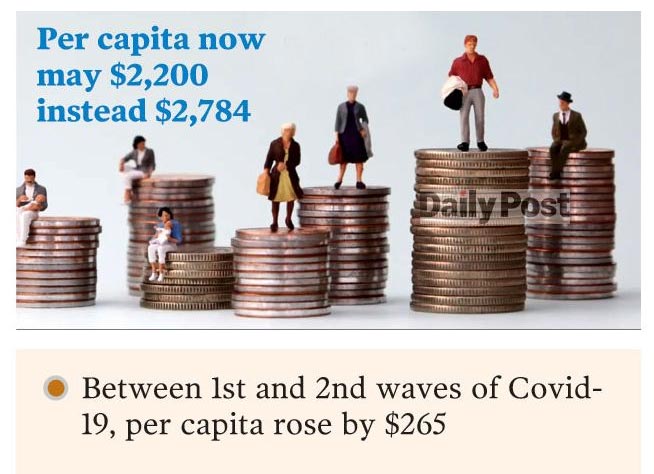-Between 1st and 2nd waves of Covid-19, per capita rose by $265
-Economic data was used to gain political advantage
-Population kept low when calculating to show higher GDP
In 2009, the Awami League (AL) government was formed, and according to BBS data, the national per capita income was $842 for FY09, rising to $946 the next year. In FY13, per capita income jumped by $127 to reach $1,274. After this, per capita income continued to increase significantly each year.
Even during the repeated lockdowns due to the Covid-19 pandemic, when economic activities stalled, considerable growth in national per capita income was reported. In FY20, prior to pandemic, the national per capita income stood at $2,326. Despite the nationwide lockdowns during the first and second waves of Covid-19, the following fiscal year saw per capita income rise by $265 to $2,591.
A committee formed by the interim government has started revealing the jugglery of the ousted Awami League government in per capita development sector.
Though the committee assigned to draft a comprehensive White Paper on the state of the country's economy has not yet made any formal disclosure, one member cited their initial findings that disclose last fiscal year's real per capita income would be $500 less than what the previous government claimed to be.
Bangladesh's per capita income could stand at $2,200 in FY24, not $2,784 put by the official statistical agency in its provisional data, said the committee member.
In 2019-20, when GDP growth fell to 3.45% – less than a half of the previous year's rate – amid Covid, Bangladesh reported per capita income of $2,326, more than a hundred dollar rise year-on-year, raising eyebrows of many as pandemic-induced lockdowns threw many out of incomes and businesses.
This happened again next fiscal year, when the pandemic was still ongoing and the economy was struggling to recover amid worldwide growth slowdown and high inflation. Bangladesh's economy grew to 6.94% and the per capita income jumped a whopping $265, a disclosure that further deepened the skepticism among economists.
The then finance minister AHM Mustafa Kamal ruled out the notion that "the government has shown too much" and attributed the growth to significant increase in import-export, revenue collection, remittance earnings.
Remittance grew in those two fiscal years mainly due to cash incentive and decline in hundi transactions during the pandemic, contributing greatly to reserves. But was that enough for the stellar growth in per capita income when people were losing jobs and earnings?
Even when Bangladesh's per capita GDP rose slightly higher than India's in 2020, analysts then pointed out that if calculated on purchasing power parity (PPP) basis, India's per capita income would be higher – meaning that Indians were able to buy more commodities with the same amount spent by Bangladeshis.
The White Paper committee now says they found evidence that growth data released by the Bangladesh Bureau of Statistics (BBS) during the Awami League regime were largely manipulated.
Among the strategies to present a better-than-reality performance of the regime was the use of favorable exchange rates, which overvalued the national currency and inflated export earnings. Another approach was the inclusion of non-productive sectors, such as excessive government expenditure, to boost domestic output figures artificially.
A strong GNI, says the White Paper committee member who wished not to be named, can attract foreign investment and funds by presenting Bangladesh as stable and economically promising, masking underlying weaknesses and allowing leaders to project a facade of growth and progress.
Bangladesh reported higher GDP growth in FY21, despite the economy facing severe impacts from the Covid-19 pandemic and significant economic disruptions.
"However, GDP growth was inflated by approximately 15%-20% in this calculation," he cited.
Meanwhile, a former official of the BBS denied the allegations of data manipulation but stated that they were required to work with secondary data over which they had no control.
The official said the agriculture ministry used to set a target for rice production. GDP figures were then adjusted to reflect these targets, regardless of actual yield.
Furthermore, expenditures by foreign visitors – such as airfare, hotel stays, and other expenses incurred during visits to Bangladesh – were frequently counted directly as part of foreign direct investment (FDI) figures, the official added.
Fahmida Khatun, executive director of CPD, said that from an economic standpoint, it is clear that both GDP size and growth rate were overstated which also inflated per capita income figures.
She added that even population figures were kept low when calculating per capita income, aiming to paint an inflated picture of development.
"This was done both through methodological adjustments and deliberate exaggeration," she said. "Economic data was used to gain political advantage."
To prevent future data tampering, the White Paper committee is expected to recommend that BBS be established as an independent entity.
This would allow the BBS to publish statistical data without needing prior approval from the Prime Minister's Office, the planning ministry, or any other external body, the committee member said.
Additionally, the committee suggests forming a strong executive-empowered commission to reform BBS' data collection methods including revising its methodology and enhancing its staffing.
Abul Kalam Azad, a former BBS director who was responsible for compiling GDP data, defended his works at the BBS, saying there is no documentation to support claims of GDP tampering. Azad said he is open to sharing his perspective with the White Paper committee if invited.
He clarified that all data came from secondary sources and if sources did not provide accurate data, he had no control over it.
Azad explained that the Bangladesh Bank's exchange rates determined how per capita income was calculated. If the Bank provided a lower rate, he had to use it for GDP calculations.
Regarding agriculture, he noted that at the beginning of the Boro and Aman seasons, the agriculture ministry would announce production targets for rice. During the GDP calculation process, the ministry would submit estimates of actual production that aligned with these targets.
"If rice production were overstated by even 2 lakh tons, it could lead to significant distortions in both the size of the GDP and the per capita income figures," he said.
Concerning foreign direct investment (FDI), Azad said the Bangladesh Investment Development Authority (BIDA) registered the actual amount of investment.
"However, to inflate FDI figures, costs incurred by foreign visitors, such as airfare and hotel expenses, were incorrectly added to FDI calculations," he said.
He explained that per capita income is calculated by dividing total national income by the total population. "The BBS estimates the population growth rate each June, but the total population figures required for GDP calculations are needed in January. If the population is reported as several hundred thousand lower, it artificially inflates per capita income."
He also pointed out significant discrepancies between census figures and population estimates obtained from the annual surveys.
Thus, the former ousted AL government manipulated the information and statistics and used it to glorify their political spectrum, agenda and established their development hegemony.
ZH



-20250710131233.jpg)


